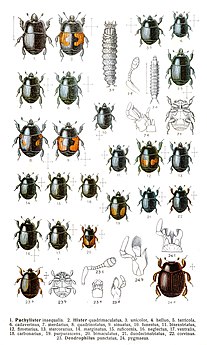
Crocus is a genus of flowering plants in the iris family comprising 90 species of perennials growing from corms. Many are cultivated for their flowers appearing in autumn, winter, or spring. The spice saffron is obtained from the stigmas of Crocus sativus, an autumn-blooming species. Crocuses are native to woodland, scrub, and meadows from sea level to alpine tundra in North Africa and the Middle East, central and southern Europe, in particular Krokos, Greece, on the islands of the Aegean, and across Central Asia to Xinjiang Province in western China.

Lathyrus is a genus in the legume family Fabaceae and contains approximately 160 species. They are native to temperate areas, with a breakdown of 52 species in Europe, 30 species in North America, 78 in Asia, 24 in tropical East Africa, and 24 in temperate South America. There are annual and perennial species which may be climbing or bushy. This genus has numerous sections, including Orobus, which was once a separate genus.
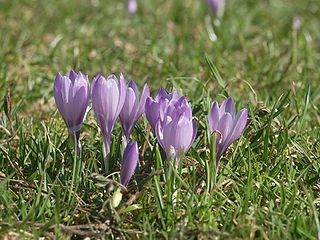
Crocus vernus is a species in Family Iridaceae, native to the Alps, the Pyrenees, and the Balkans. Its cultivars and those of Crocus flavus are used as ornamental plants. The Dutch Crocusses are larger than the other cultivated crocus species. Depending on the year, Crocus vernus starts flowering about the same time or up to 2 weeks after Crocus chrysanthus starts flowering. Height: 4–6" (10–15 cm).

The Encyclopedia of Life (EOL) is a free, online collaborative encyclopedia intended to document all of the 1.9 million living species known to science. It is compiled from existing databases and from contributions by experts and non-experts throughout the world. It aims to build one "infinitely expandable" page for each species, including video, sound, images, graphics, as well as text. In addition, the Encyclopedia incorporates content from the Biodiversity Heritage Library, which digitizes millions of pages of printed literature from the world's major natural history libraries. The project was initially backed by a US$50 million funding commitment, led by the MacArthur Foundation and the Sloan Foundation, who provided US$20 million and US$5 million, respectively. The additional US$25 million came from five cornerstone institutions—the Field Museum, Harvard University, the Marine Biological Laboratory, the Missouri Botanical Garden, and the Smithsonian Institution. The project was initially led by Jim Edwards and the development team by David Patterson. Today, participating institutions and individual donors continue to support EOL through financial contributions.

Lathyrus vernus is a species of flowering herbaceous perennial plant in the genus Lathyrus, native to forests of Europe and Siberia. It forms a dense clump of pointed leaves with purple flowers in spring, shading to a greenish-blue with age.
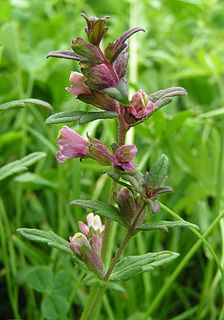
Odontites vernus, the red bartsia, is a wild flower from the Broomrape family native to Europe and Asia and occurring as an alien in North America. The red bartsia is a common plant in low-fertility soils, where it lives partially as a parasite on the roots of grasses. The red bartsia has pinkish and red flowers from June to September. They prefer dry conditions and full sun light exposure and are pollinated by bees and wasps. Over the last 70 years, the red bartsia has disappeared from many woodland locations in the English county of Dorset.

Paleacrita vernata, the spring cankerworm, is a moth of the family Geometridae. The species was first described by William Dandridge Peck in 1795. It is found in North America from the Atlantic Ocean west to Alberta, Texas and California.
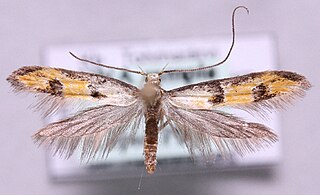
Heinemannia laspeyrella is a species of moth of the family Elachistidae. It is found in northern, central and eastern Europe. In the east, the range extends up the Ural and in the south to Siberia.

iNaturalist is a citizen science project and online social network of naturalists, citizen scientists, and biologists built on the concept of mapping and sharing observations of biodiversity across the globe. iNaturalist may be accessed via its website or from its mobile applications. Observations recorded with iNaturalist provide valuable open data to scientific research projects, conservation agencies, other organizations, and the public. The project has been called "a standard-bearer for natural history mobile applications."

Erigeron vernus is a North American species of flowering plant in the daisy family known by the common name early white-top fleabane. It is native to the southeastern United States from Virginia to Louisiana.

Bombus pyrenaeus is a species of bumblebee. It is native to Europe, where it occurs in Andorra, Austria, Bulgaria, France, Germany, Greece, Italy, Macedonia, Montenegro, Poland, Romania, Serbia, Slovakia, Slovenia, Spain, Switzerland, and Ukraine. Its German-language common name is Pyrenäenhummel. It is a common species, becoming abundant in some areas.
New Vernon is a hamlet in Orange County, in the U.S. state of New York.
Strigister tecolotito is a species of clown beetle in the family Histeridae. It is found in North America.
Strigister is a genus of clown beetles in the family Histeridae. There are at least two described species in Strigister.
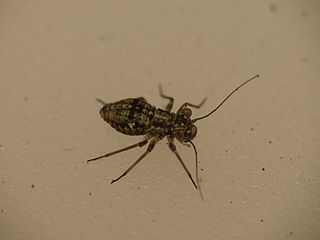
Mesopsocus is a genus of middle barklice in the family Mesopsocidae. There are more than 60 described species in Mesopsocus.
Phelister subrotundus is a species of clown beetle in the family Histeridae. It is found in North America.
Phelister is a genus of clown beetles in the family Histeridae. There are more than 90 described species in Phelister.
Phelister brevistriatus is a species of clown beetle in the family Histeridae. It is found in Central America and North America.
Heterothrips is a genus of thrips in the family Heterothripidae. There are more than 60 described species in Heterothrips.
Phelister haemorrhous is a species of clown beetle in the family Histeridae. It is found in Europe & Northern Asia, Central America, and South America.
